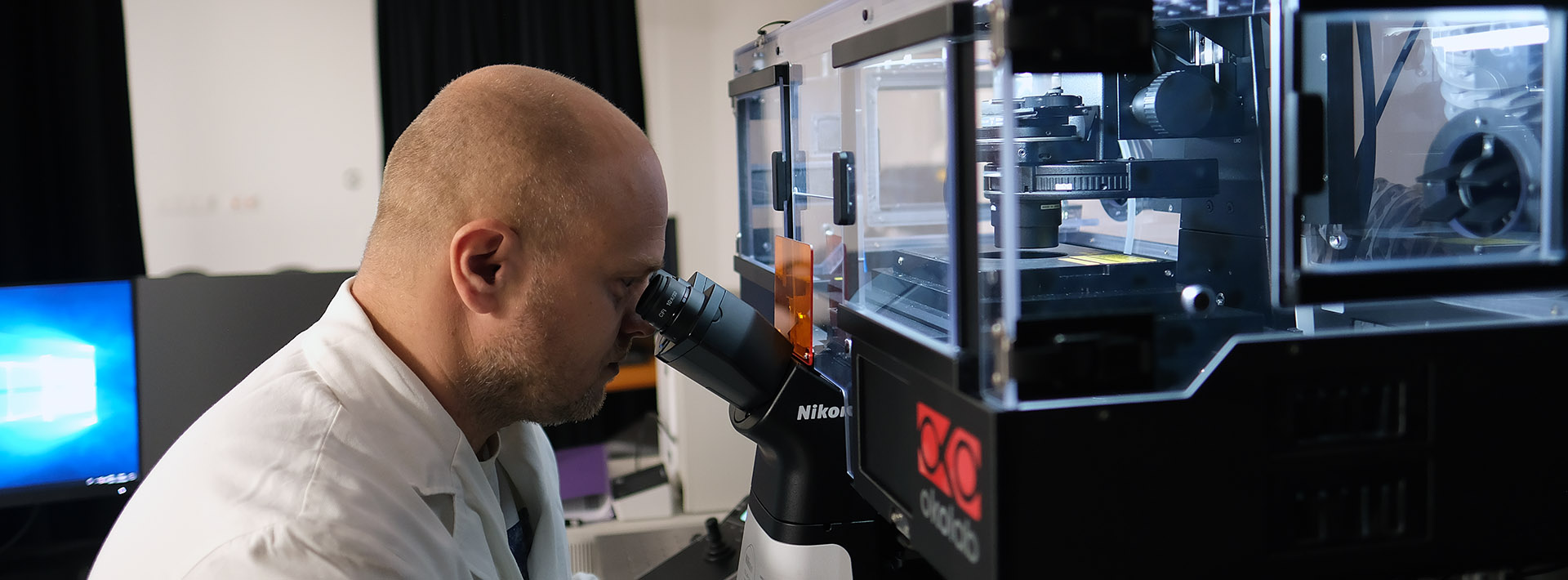Daten
Offizielle Daten in der Fachveröffentlichung für das folgende akademische Jahr: 2020-2021
Lehrbeauftragte/r
-
Dr. István Miklós ÁBRAHÁM
professor,
Institute of Physiology -
Semesterwochenstunden
Vorlesungen: 0
Praktika: 28
Seminare: 0
Insgesamt: 28
Fachangaben
- Kode des Kurses: OBA-125-G
- 2 kredit
- Biotechnology MSc
- Basic modul
- autumn
OBA-110-E parallel
Zahl der Kursteilnehmer für den Kurs:
min. 5 – max. 24
Thematik
The goal of the course is to disclose human physiological processes to the students. By means of the knowledge of complex human physiological processes the biotechnology students will also learn the interconnections and mutual influences of physiological systems and they will utilize their knowledge in planning and executing related animal model experiments and pharmaceutical tests.
Vorlesungen
Praktika
- 1. Blood. Red blood cell and differential leukocyte count, blood groups, osmotic resistance of red blood cells.
- 2. Blood. Red blood cell and differential leukocyte count, blood groups, osmotic resistance of red blood cells.
- 3. Heart. In situ and isolated frog's heart. Stannius ligatures. Cardiac cycle. Extrasystole.
- 4. Heart. In situ and isolated frog's heart. Stannius ligatures. Cardiac cycle. Extrasystole.
- 5. Electrocardiography and phonocardiography.
- 6. Electrocardiography and phonocardiography.
- 7. Circulation. Arterial blood pressure and pulse. Microcirculation. Effects of adrenaline and acetylcholine.
- 8. Circulation. Arterial blood pressure and pulse. Microcirculation. Effects of adrenaline and acetylcholine.
- 9. Respiration Spirometry: lung volumes, capacities and dynamic parameters. Compliance.
- 10. Respiration Spirometry: lung volumes, capacities and dynamic parameters. Compliance.
- 11. Measurement of metabolic rate. Basal and actual metabolic rate.
- 12. Measurement of metabolic rate. Basal and actual metabolic rate.
- 13. Reproductive physiology: Estrous cycle, menstrual cycle. Pregnancy tests.
- 14. Mid-term student report.
- 15. Carbohydrate metabolism: detection of blood glucose, glucose tolerance test, diabetes mellitus.
- 16. Carbohydrate metabolism: detection of blood glucose, glucose tolerance test, diabetes mellitus.
- 17. Electrical stimulation of peripheral nerve. Electrotonic potentials, action potentials. Cathode make and anode break excitations.
- 18. Electrical stimulation of peripheral nerve. Electrotonic potentials, action potentials. Cathode make and anode break excitations.
- 19. Compound and single fiber action potential, conduction velocity, chronaxy and rheobase.
- 20. Compound and single fiber action potential, conduction velocity, chronaxy and rheobase.
- 21. Muscle physiology: Summation, superposition, incomplete and complete tetanus. Fatigue. Electromyography.
- 22. Muscle physiology: Summation, superposition, incomplete and complete tetanus. Fatigue. Electromyography.
- 23. Central nervous system physiology I.: Reflexes. Stereotaxic technique.
- 24. Central nervous system physiology I.: Reflexes. Stereotaxic technique.
- 25. Central nervous system physiology II.: Sensory systems.
- 26. Central nervous system physiology II.: Sensory systems.
- 27. Central nervous system physiology III.: Electroencephalography, evoked potential, sleep.
- 28. Central nervous system physiology III.: Electroencephalography, evoked potential, sleep.
Seminare
Materialien zum Aneignen des Lehrstoffes
Obligatorische Literatur
Guyton & Hall: Textbook of Medical Physiology (Elsevier), 13th ed., 2015.
Vom Institut veröffentlichter Lehrstoff
Figures of the lectures given are available on the homepage of Institute of Physiology and on the Neptun Meet Street.
Important messages on new information will be announced at the lectures and will be sent to you by course mails.
Please always find the current updated information and study materials on the homepage of the Institute of Physiology (physiology.aok.pte.hu).
Skript
Find and read the relevant chapters in:
Homepage of PTE ÁOK Institute of Physiology: Physiology Lab Practices 1, internet study material, printable notebook, 2019
Homepage of PTE ÁOK Institute of Physiology: Physiology Lab Practice Worksheets 1, internet study material, printable notebook, 2019
Homepage of PTE ÁOK Institute of Physiology: Physiology Lab Practices 2, internet study material, printable notebook, 2019
Homepage of PTE ÁOK Institute of Physiology: Physiology Lab Practice Worksheets 2, internet study material, printable notebook, 2015
Empfohlene Literatur
Linda S. Costanzo: Physiology 5th ed., 2013;
Walter F. Boron, Emile L. Boulpaep: Medical Physiology 2nd ed. 2012
Voraussetzung zum Absolvieren des Semesters
Maximum of 15 % absence allowed
Semesteranforderungen
Regular oral reports at the lab practices.
Möglichkeiten zur Nachholung der Fehlzeiten
The missed lab practice is advised to be covered by joining another group while the same topic is on schedule.
Prüfungsfragen
Questions for the lab practice report:
1. Blood. Red blood cell and differential leukocyte count, blood groups, osmotic resistance of red blood cells.
2. Heart. In situ and isolated frog's heart. Stannius ligatures. Cardiac cycle. Extrasystole.
3. Electrocardiography and phonocardiography.
4. Circulation. Arterial blood pressure and pulse. Microcirculation. Effects of adrenaline and acetylcholine.
5. Respiration. Spirometry: lung volumes, capacities and dynamic parameters. Compliance.
6. Measurement of metabolic rate. Basal and actual metabolic rate.
7. Reproductive physiology: Estrous cycle, menstrual cycle. Pregnancy tests.
8. Carbohydrate metabolism: detection of blood glucose, glucose tolerance test, diabetes mellitus.
9. Electrical stimulation of peripheral nerve. Electrotonic potentials, action potentials. Cathode make and anode break excitations.
10. Compound and single fiber action potential, conduction velocity, chronaxy and rheobase.
11. Muscle physiology: Summation, superposition, incomplete and complete tetanus. Fatigue. Electromyography.
12. Central nervous system physiology I.: Reflexes. Sensory systems.
13. Central nervous system physiology II.: Electroencephalography, Stereotaxic technique.
Study material for the exam is the sum total of information covered in the obligatory textbook, on the homepage of the Institute, as well as knowledge given at the lectures and lab practices.
Prüfer
Praktika, Seminarleiter/innen
- Dr. Lengyel Ferenc
